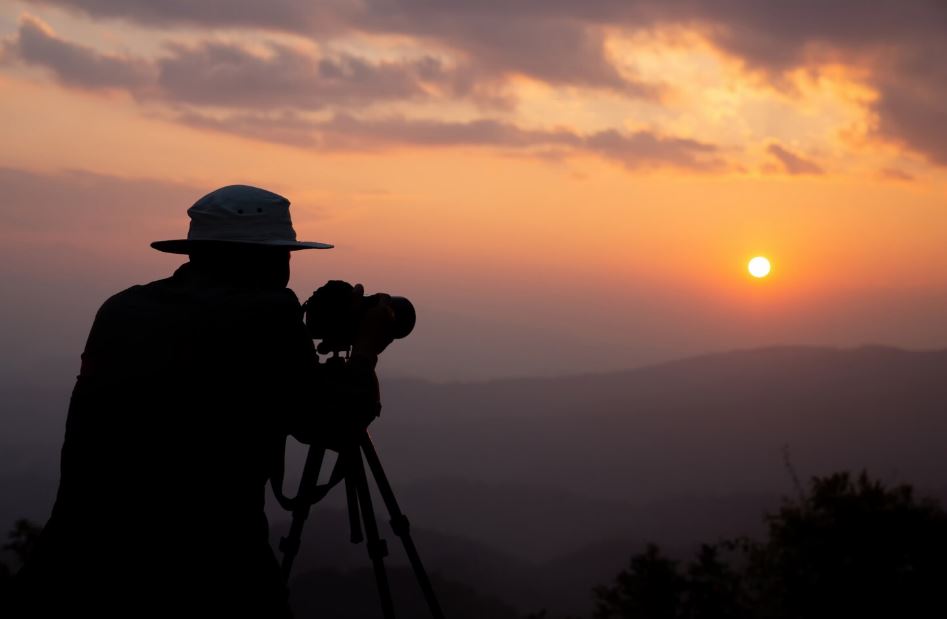
It’s rare that the most captivating sunset photo is the one you expect. It usually occurs after the crowd has left for home, the tripods have been folded, and the conversation has subsided. Experts with a knack for the spectacular remain behind, anticipating a fleeting and frequently disregarded phenomenon—the afterglow that renders the opposite horizon in hues so striking they seem unreal.
This technique, which is subtly praised by professional photographers, is incredibly successful at creating photographs that seem unique and unrepeatable. Catching the subtle magic that occurs when light, released from its blinding source, bounces through the atmosphere and bathes the landscape in a painterly mix of pinks, purples, and soft blues is more important than chasing the obvious spectacle of the sun sinking.
Key Related Information
| Detail | Information |
|---|---|
| Best time for sunset trick | 30 minutes before to 30 minutes after sunset |
| Ideal weather | High, scattered clouds or after rainfall |
| Core technique | Turn away from the sun post-sunset to capture reflected light |
| Common mistake | Leaving too soon after the sun dips below horizon |
| Essential tools | Tripod, wide-angle lens, exposure bracketing |
| Recommended cameras | Full-frame mirrorless or DSLR with high dynamic range |
| Celebrity usage | Featured in fashion, travel, and lifestyle editorials |
| Social media benefit | Unique tones that increase engagement and shares |
| Professional application | Common in wedding, commercial, and destination shoots |
| Reference source | Directionally Challenged Traveler |
For years, fashion photographers have relied on this method. Because the sun had already set, models in some Vogue spreads appear to be surrounded by golden light without even a single sunbeam visible. In places like Santorini, Malibu, or the Amalfi Coast, where the post-sunset light accentuates whitewashed walls, sandy cliffs, or even fabric textures in ways that direct sunlight cannot, travel campaign photographers employ the same technique.
It’s a simple but fascinating science. Warmer colors take center stage as the sun’s rays spread farther when it is two degrees below the horizon, dispersing more blue light. The effect is amplified if there are high, broken clouds in the sky, resulting in layers of reflected color at various elevations. Even an ordinary hill or a group of trees can appear almost cinematic under these circumstances.
The emotional depth of this trick is encapsulated in the personal story of one couple. The husband secretly took pictures of the skies over the course of five years, not during the main event but in the silence that followed—on anniversaries, reconciliations, and even the night he proposed. A timeline of their relationship was later created by framing the photos together. While some skies were remarkably colorful, others were gloomy and muted. All bore the burden of selected and treasured moments. It’s the type of artistic output that results from refusing to leave the stage when the show is about to end.
The value of this strategy has only increased due to social media’s constant appetite for novelty. In contrast to the abundance of orange-hued photos on the hashtag #sunsetphoto, reverse horizon photos’ cool violets and surprising magentas are striking. The audience feels as though they are witnessing something unique, even if it is only the result of timing and patience, and engagement rates increase as shares increase.
The advantages are especially noteworthy in the business sector. The fiery drama of the sunset itself and the delicate elegance of the afterglow are two completely different moods that can be achieved in a single evening shoot. For brands, this dual return on investment is very effective because it enables them to add contrasting atmospheres to campaigns without having to pay for extra sessions.
To perform the trick effectively, you must be prepared. To forecast where and when the light will fall after sunset, many professionals use apps like The Photographer’s Ephemeris. For example, if the timing is right, a village square in Greece could be illuminated with gentle pink light. Just minutes after the sun sets, mist in the Scottish Highlands can turn into a luminous veil.
This is a philosophical as well as a technical lesson. Like great storytelling, great photography frequently arises in the silences between the beats. The afterglow has the ability to ingrain itself more deeply into the memory than the main event itself, much like a musician’s lingering note can haunt the listener or a movie’s subdued post-climax scene can leave the strongest impression.
Naturally, there is a risk of overexposure, just like with any creative secret. A method may lose some of its novelty once it is used extensively. Location, weather, composition, and individual vision guarantee that no two afterglow photos are ever the same, making this technique unique more in how each photographer interprets it than in the technique itself.
Therefore, the next time you find yourself on a beach, rooftop, or hillside at the end of the day, try not to get up and leave as soon as the sun sets. With everyone else watching, turn your back on the horizon. Breathe, adjust your lens, and wait. You might just catch a picture that is more potent than the sunset itself—a frame that seems more like a whispered secret that you were fortunate enough to hear than a photograph.

